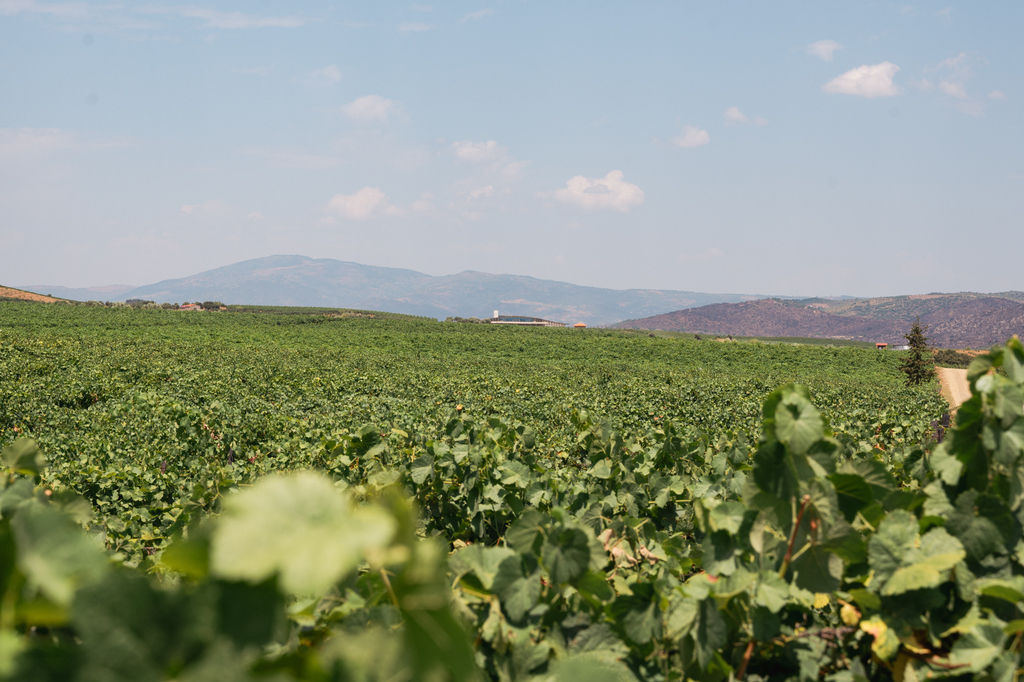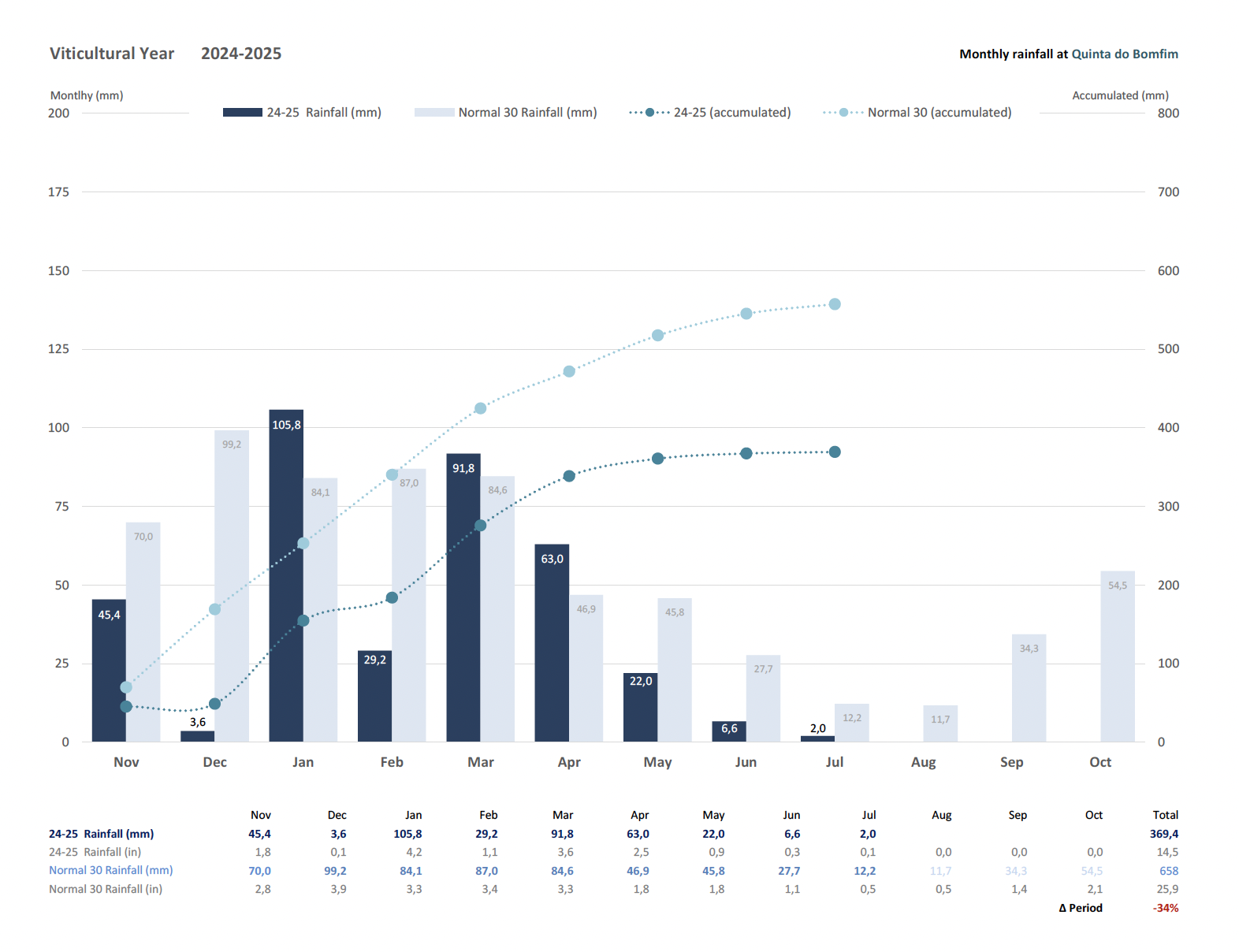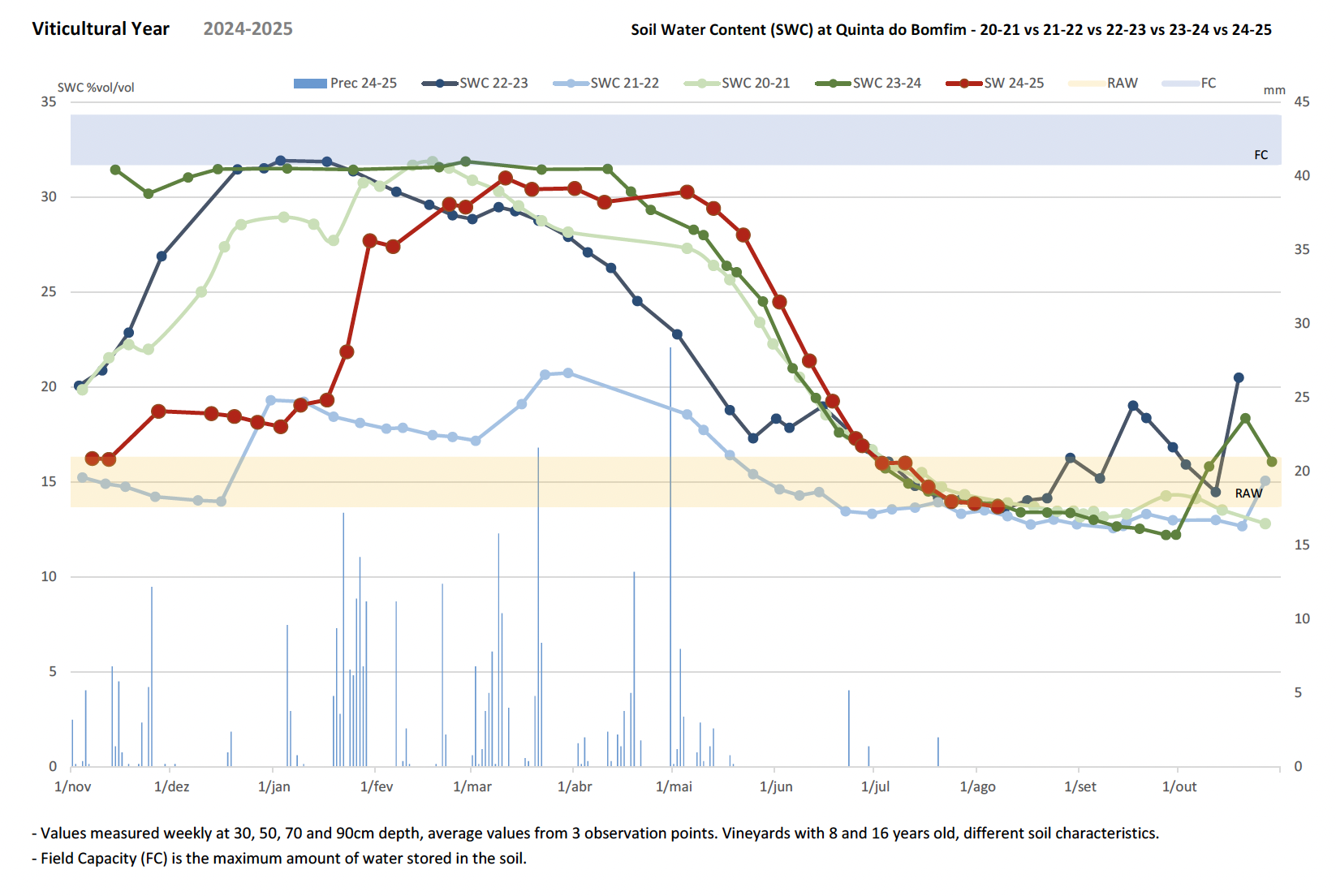
Viticulture Bulletin – Spring & Summer 2025
Synopsis
By the end of the period under review (April to July), the accumulated rainfall for this viticultural cycle showed a shortfall of 34%. Although reasonable precipitation was recorded during the winter and spring, there was next to no rain during June and July and this was compounded by the surge in temperatures which came in tandem. So far this summer we have recorded four heatwaves: one in mid-June, one shared between late June and early July, another at the end of July, and yet another during the first half of August (the latter being the longest and most intense heatwave this century in the Douro).
Fig.1: Quinta do Bomfim – Viticultural Year 2024/25 – Monthly rainfall

April was a wet month with above average rainfall recorded in all our weather stations, across the three regions where we grow grapes. We had 53% more rainfall across the Douro quintas (average from our nine weather stations there); 32% more at Fonte Souto in Portalegre, whilst Casa de Rodas in the Minho took top honours with an unusual 129% more rain than would be expected for the month. Temperatures in the Douro were moderate: half the weather stations showing marginally above-average, and the other half visibly below-average figures (ranging from -0.8°C at Ataíde and -1.8°C at Canais). At Casa de Rodas the average monthly temperature deviated +1.1°C from the mean and at Quinta da Fonte Souto +1.6°C. Soil water availability (Bomfim soil probes) was the highest ever recorded at this time of the year (30.27% - very close to field capacity).
May brought a mixed picture to the Douro: the first half was moderately wet with close to average temperatures, whilst the second half was very dry with next to no rainfall and a gradual rise in temperatures. Levels of precipitation in the Alentejo and the Minho were more favourable, respectively, half the expected rainfall at Fonte Souto and fractionally above the monthly average at Casa de Rodas where average temperature was 1°C above average, compared to 2°C above the monthly average at Fonte Souto. Encouragingly, soil water availability (Douro) at the end of May, at 24.48%, was the highest level recorded in the last five years (for this period of the year).
June brought two heat waves to the Douro, the first between June 15 and 20 and the second starting on the 27th and prolonging into the first days of July with several consecutive days of maximum temperatures exceeding 40°C. Average temperatures were, unsurprisingly, noticeably higher than the 30-year average, with Cavadinha registering the highest deviation from the norm: +3.2°C. The highest temperature was logged at Malvedos, 43.2°C on the 29th and the highest minimum temperature at Vesúvio: 22.6°C on the 19th. At the end of the month there were several consecutive tropical nights, i.e. when the minimum temperature does not go below 20°C. None of our Douro weather stations recorded anywhere near the average monthly rainfall and in most quintas it was negligible (just 6mm at Bomfim). At the end of June, accumulated rainfall (November ’24 – June ’25) was 33% below the 30-year average. Conditions at Quinta da Fonte Souto and Casa de Rodas were not as extreme, temperature wise, although just as dry as in the Douro. An alarming exception was the night of June 30th at
Fonte Souto when the minimum temperature did not descend below 28.9°C! On a positive note, soil water availability stood at 16%, which makes 2025 – at this juncture in the viticultural cycle – the year with the most favourable levels of soil water over recent years.
The dry spell continued into July and at Bomfim only 2mm of rain were recorded during the entire month (the 30-year average for July is 12.2mm). Average temperature at 26.9°C was +1.7°C for the month. Minimum temperatures were consistently above 20°C for the first nine days of July, i.e., nine ‘tropical nights’ in a row. Although maximum temperatures abated a little between July 18 and 21, they crept back up above the 35°C mark until the end of the month and into August.
During the first half of August, we recorded the longest and most intense heatwave thus far this century. Between August 3 and 12, maximum temperatures were invariably above 40°C. This 10-day heatwave surpassed the summer of 2003 when we had seven consecutive days with maximum temperatures hovering between 40.5 and 42.4°C. As we go to press (mid-August) not a single drop of rain has been recorded.
Flowering
Flowering was recorded from May 19 for both the Touriga Franca and the Touriga Nacional, which is to say, 11 and 10 days later than average, respectively. This delay can be explained by the climatic conditions observed between budbreak and the beginning of May, which slowed the pace of development. However, the sudden rise in temperatures during the second half of May, coupled with good soil water availability meant that the flowering period was swift and concentrated, without the usual delay between different locations. Fruit set progressed favourably without incident.
Pintor (Veraison)
The start of the pintor in the Touriga Franca was in line with average dates and by mid-July, most locations had completed 50% of this phase. Touriga Nacional evolved more slowly, and the 50% marker was reached on July 24, about a week later than average. Normally there is a time lag in the pintor between the two varieties, but this year the gap was a little bigger.
As this bulletin goes to press, our viticulture team is busy in the field conducting maturation studies, but at this stage signs point to an average year in terms of the progression of the cycle and the quality potential looks ‘interesting’. First grapes picked this week by our partner at Caves Transmontanas (our Douro sparkling wine joint venture) shows berry sizes about 30% smaller than average. This appears to reflect the very hot conditions of the last couple of months, but to get a fuller picture for our port and Douro DOC grapes we will have to wait for
the outcome of the maturation studies over the next two to three weeks.
Fig.2: Quinta do Bomfim – Viticultural Year 2024/25 – Soil Water Content

Fernando Alves, Miguel Potes and Joana Valente · August 14, 2025


